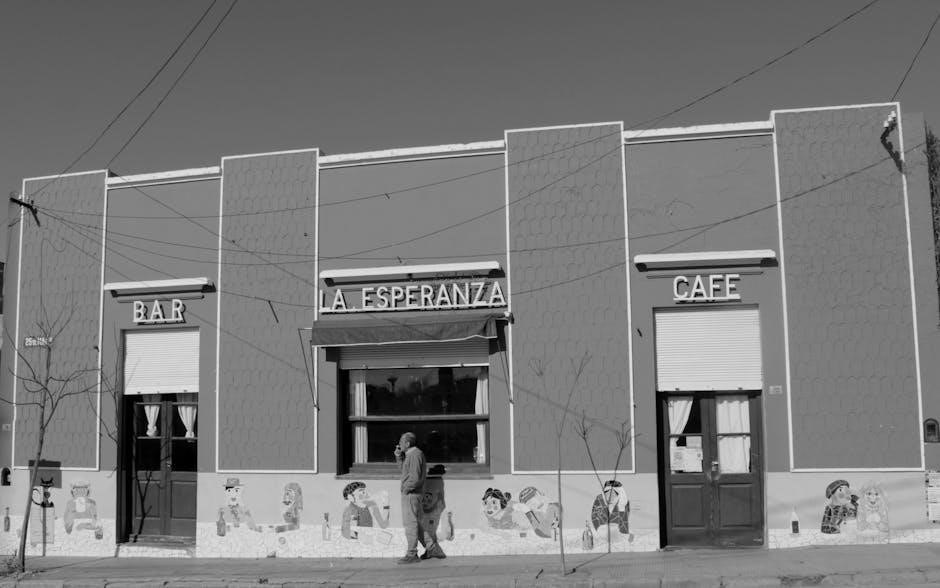Esperanza Renace, or Esperanza Rising, is a compelling novel by Pam Muñoz Ryan that follows Esperanza, a young girl, as she navigates a journey from wealth to hardship. The title reflects Esperanza’s resilience and growth amidst tragedy, symbolizing hope and transformation during the Great Depression.
Overview of “Esperanza Renace”
Esperanza Renace, or Esperanza Rising, is a heartwarming yet poignant novel by Pam Muñoz Ryan. It tells the story of Esperanza, a young girl who transitions from a life of privilege in Mexico to one of hardship in California during the Great Depression. The novel explores themes of loss, resilience, and identity as Esperanza adapts to her new reality in a farm workers’ camp. The title reflects her journey of rising above adversity, symbolizing hope and transformation. The book is celebrated for its vivid imagery, emotional depth, and historical relevance, making it a powerful tale of self-discovery and strength.
Significance of the Title
The title Esperanza Renace holds profound significance, as it encapsulates the essence of Esperanza’s journey. The Spanish phrase translates to Esperanza Rising, symbolizing her transformation from a life of comfort to one of resilience. The title reflects her ability to rise above the tragedies she faces, embodying the themes of hope and renewal. The use of her name, Esperanza, meaning “hope” in Spanish, underscores her inner strength and determination to rebuild her life. The title is a powerful metaphor for her growth and the enduring spirit of hope that guides her through adversity, making it a fitting representation of her story.

Background Information
Esperanza Renace, written by Pam Muñoz Ryan, was published in 2000. The novel is inspired by the author’s family history, offering a poignant portrayal of resilience during the Great Depression.
Author Pam Muñoz Ryan
Pam Muñoz Ryan is an award-winning author known for her lyrical and emotionally resonant storytelling. Born in California, she draws inspiration from her Mexican heritage and family history. Esperanza Renace, her most celebrated work, reflects her ability to weave historical and cultural themes into compelling narratives. Ryan’s writing often explores themes of identity, resilience, and hope, making her a beloved figure in children’s literature. Her work has earned numerous accolades, solidifying her reputation as a masterful storyteller who touches hearts with her vivid characters and poignant stories.
Publication Details
Esperanza Renace, written by Pam Muñoz Ryan, was first published in 2003. This award-winning novel is available in various formats, including hardcover, paperback, and digital versions such as PDF and flipbook formats. The book has gained widespread popularity, with many readers accessing it through online platforms. Its availability in multiple formats has made it accessible to a broad audience, including students and general readers. The story’s universal themes and historical context continue to resonate with readers, making it a timeless piece of literature. The PDF version is particularly popular for its convenience and ease of access, allowing readers to engage with Esperanza’s journey anytime, anywhere.

Plot Summary
Esperanza Renace follows Esperanza, a young girl from a wealthy Mexican family, whose life is upended by tragedy. After her father’s sudden death, Esperanza and her mother flee to California during the Great Depression, navigating poverty, loss, and resilience as they adapting to a harsh new reality.
Setting: Mexico and California
The story begins on Esperanza’s family ranch, El Rancho de las Rosas, in Mexico, where she enjoys a life of privilege surrounded by wealth and tradition. The ranch, with its lush vineyards and vibrant culture, symbolizes her idyllic childhood. However, after a tragic event, Esperanza and her mother flee to California during the Great Depression, settling in a starkly different environment—a farm workers’ camp. The contrast between the lush ranch and the harsh, barren conditions of the camp underscores Esperanza’s journey of resilience and adaptation. These two settings shape her identity and experiences, highlighting themes of loss and transformation.
The Tragedy That Changes Everything
The sudden and devastating murder of Esperanza’s father shatters her life of privilege on El Rancho de las Rosas. This tragic event forces Esperanza and her mother to flee Mexico, leaving behind their wealth and status. The loss of her father and their luxurious lifestyle plunges Esperanza into a world of uncertainty and hardship. The tragedy not only alters her circumstances but also reshapes her identity, as she must confront the harsh realities of poverty and displacement during the Great Depression. This pivotal moment sets the stage for Esperanza’s journey of resilience and self-discovery, transforming her from a sheltered child into a strong, determined individual.
Journey to California During the Great Depression
Following her father’s tragic murder, Esperanza and her mother embark on a perilous journey from Mexico to California during the Great Depression. The once-privileged girl experiences a stark reality as they travel in harsh conditions, leaving behind their luxurious life. Upon arrival, they settle in a farm workers’ camp, where Esperanza confronts the struggles of poverty and labor. The journey marks a dramatic shift from her sheltered existence to a life of hardship, forcing her to adapt and grow. This transition underscores Esperanza’s resilience as she faces the challenges of a new and unfamiliar world, far from the comfort of her family’s ranch.
Life in a Farm Workers’ Camp
Life in the farm workers’ camp is a stark contrast to Esperanza’s previous life of luxury. The camp is crowded, with limited resources and poor living conditions. Esperanza and her mother struggle to adapt to the harsh environment, where they face hunger, exhaustion, and the constant demand for labor. Despite these challenges, Esperanza learns to contribute by working in the fields and helping her mother, discovering inner strength she never knew she had. The camp becomes a place of both hardship and growth, shaping Esperanza’s understanding of resilience and the importance of family. This experience profoundly changes her perspective on life and identity.

Themes in the Book
The novel explores themes of loss, resilience, identity, belonging, and feminist determination, highlighting Esperanza’s journey of self-discovery and growth amidst hardship.
Loss and Resilience
Esperanza Renace deeply explores the themes of loss and resilience, as Esperanza faces the sudden death of her father and the subsequent collapse of her privileged life. Forced to flee Mexico with her mother, she encounters the harsh realities of poverty and labor in California during the Great Depression. The novel highlights her emotional journey from grief to adaptation, as she learns to navigate a world far removed from her former comforts. Through her struggles, Esperanza discovers inner strength and resourcefulness, transforming her loss into a foundation for growth and hope. This theme resonates powerfully, inspiring readers to reflect on their own capacity for resilience in the face of adversity.
Identity and Belonging
Esperanza Renace delves into the themes of identity and belonging, as Esperanza navigates a shift from her privileged life in Mexico to a humble existence in California. Her journey challenges her sense of self, as she grapples with her Mexican heritage and her new reality as a farm worker. Initially, Esperanza struggles to reconcile her former pride in her family’s wealth with her current circumstances, feeling disconnected from both her past and her surroundings. However, through her experiences, she gradually embraces her roots and finds a sense of belonging among fellow workers, fostering a deeper understanding of her identity and the strength it provides in the face of uncertainty.
Feminist Determination and Family History
Esperanza Renace highlights feminist determination through Esperanza’s journey, as she evolves from a sheltered girl to a resilient young woman. The novel underscores the strength of female characters, particularly Mama and Abuelita, who embody courage and resourcefulness. Esperanza’s growth is deeply rooted in her connection to her family history, as she learns to value her heritage and the sacrifices made by her ancestors. The story reflects Ryan’s own family history, where women played pivotal roles in overcoming adversity. This theme emphasizes the importance of female empowerment and the enduring impact of familial bonds in shaping Esperanza’s identity and determination to rise above her challenges.

Characters
Esperanza, the protagonist, evolves from a privileged girl to a resilient young woman. Her mother, Mama, embodies strength and love, while Papa and Abuelita provide wisdom and support, shaping Esperanza’s journey.
Esperanza: The Protagonist
Esperanza is a young girl born into a privileged life on her family’s Mexican ranch, El Rancho de las Rosas. She is initially sheltered and naive, enjoying the comforts of wealth and her close-knit family. However, her life takes a dramatic turn when tragedy strikes, forcing her to confront harsh realities. As she navigates poverty, loss, and the challenges of migrant work in California, Esperanza learns resilience and the value of hard work. Her journey is one of self-discovery, as she transforms from a pampered child to a strong, independent individual. Through her experiences, Esperanza finds her voice and learns to embrace her identity, becoming a symbol of hope and determination.
Mama: Esperanza’s Mother
Mama is Esperanza’s loving and supportive mother, who plays a pivotal role in her daughter’s journey. She is kind, nurturing, and deeply devoted to her family. When tragedy strikes, Mama’s strength and resilience shine as she guides Esperanza through unimaginable challenges. Her wisdom and compassion help Esperanza adapt to their new life in California, teaching her the value of hard work and humility. Mama’s unwavering love and determination serve as a constant source of comfort and inspiration for Esperanza, aiding her transformation from a sheltered child to a strong, independent individual. Mama’s character embodies grace, courage, and the unbreakable bond of motherly love.
Papa: Esperanza’s Father
Papa, Esperanza’s father, is a kind and proud man who owns a vineyard in Mexico. He adores his daughter and often includes her in traditional tasks, such as cutting grapes, despite her being an only child. Papa’s tragic death serves as a turning point in the story, forcing Esperanza and her mother to flee to California. His legacy lives on through Esperanza, who carries his memory and values with her. Papa’s strength and love for his family are central to Esperanza’s identity, shaping her resilience and determination. His presence, though cut short, deeply influences Esperanza’s journey and growth throughout the novel.
Abuelita: Esperanza’s Grandmother
Abuelita, Esperanza’s wise and loving grandmother, plays a significant role in shaping Esperanza’s early life. She teaches Esperanza traditional skills and offers emotional support, serving as a source of comfort and guidance. Abuelita’s presence is deeply rooted in their Mexican heritage, and her wisdom helps Esperanza understand her identity. Despite the family’s hardships, Abuelita remains a symbol of strength and resilience. Her decision to stay in Mexico while Esperanza and her mother flee to California adds a layer of complexity to their relationship, leaving Esperanza with a sense of loss but also a connection to her roots. Abuelita’s influence continues to inspire Esperanza throughout her journey.

Historical Context
Esperanza Renace is set during the Great Depression, a time of economic hardship and mass migration. The novel reflects the struggles faced by Mexican immigrants in California, particularly in agricultural settings, during this period of significant social and economic change.
The Great Depression and Its Impact
The Great Depression, spanning the 1930s, brought severe economic hardship globally. In Esperanza Renace, this era forces Esperanza and her mother to flee Mexico for California. The Depression’s impact is evident in the struggles of migrant workers, inadequate living conditions, and limited opportunities. The novel portrays the harsh realities of poverty, unemployment, and social inequality, highlighting the resilience of those affected. Esperanza’s journey reflects the broader experiences of many during this time, emphasizing themes of loss, adaptation, and hope amidst adversity. The Depression’s backdrop underscores the novel’s exploration of class, identity, and survival.
Mexican Immigration to the United States
Mexican immigration to the U.S., particularly during the early 20th century, was driven by economic hardship, political instability, and the promise of work. In Esperanza Renace, Esperanza and her mother flee Mexico after a family tragedy, joining many others seeking better opportunities in California. The novel portrays the challenges of immigration, including arduous journeys, harsh living conditions, and cultural adjustments. It highlights the resilience of Mexican immigrants who, despite facing discrimination and exploitation, worked tirelessly in agricultural fields to survive. The story aligns with historical accounts of Mexican immigrants during this period, emphasizing their contributions and struggles in a new land.

Symbolism and Imagery
The vineyard symbolizes tradition and heritage, while the harvest marks time’s passage in Esperanza’s life. These elements connect her journey to themes of growth and transformation, enriching the narrative deeply.
The Vineyard as a Symbol of Tradition
The vineyard in Esperanza Renace symbolizes tradition, heritage, and continuity. It represents Esperanza’s idyllic life in Mexico, where her family’s legacy is rooted in the land and its annual harvest. The vineyard serves as a connection to her father’s pride and the family’s history, highlighting the cyclical nature of time and the enduring strength of cultural roots. The author uses the vineyard to illustrate Esperanza’s deep-seated attachment to her past, making its loss a pivotal moment in her journey toward resilience and self-discovery.
The Harvest as a Marker of Time
The harvest in Esperanza Renace serves as a poignant marker of time, reflecting the cyclical nature of life and Esperanza’s personal growth. Each harvest symbolizes the passage of another year, deeply rooted in tradition and family legacy. Esperanza’s connection to the harvest is emotional, as it represents her father’s pride and the prosperity of their vineyard. The author uses the harvest to underscore the inevitability of change, as Esperanza’s life is forever altered when tragedy strikes. This recurring theme highlights the contrast between her idyllic past and the uncertain future she faces, making the harvest a powerful symbol of time’s relentless progression.

Reception and Reviews
Esperanza Renace has received widespread critical acclaim for its powerful storytelling and emotional depth, earning numerous awards and becoming a favorite among both readers and educators.
Critical Acclaim and Awards
Esperanza Renace has garnered significant critical acclaim for its poignant storytelling and rich cultural themes. Pam Muñoz Ryan’s masterful portrayal of Esperanza’s journey earned the novel the prestigious Pura Belpré Medal. Critics praise its emotional depth, vivid imagery, and historical relevance, making it a standout in children’s literature. The book is frequently recommended for its ability to resonate with readers of all ages, offering insights into resilience, identity, and family bonds. Its acclaim has solidified its place as a modern classic, widely celebrated for its universal appeal and educational value.
Popularity Among Readers
Esperanza Renace has captivated readers worldwide with its heartfelt narrative and universal themes. The book’s popularity stems from its relatable portrayal of resilience and hope, resonating with readers of all ages. Many have praised its vivid storytelling and emotional depth, making it a favorite in both educational and personal reading settings. The novel’s ability to connect with diverse audiences has led to its widespread acclaim, with readers appreciating its cultural richness and historical context. Its accessibility in formats like PDF has further boosted its reach, allowing more readers to engage with Esperanza’s inspiring journey and the timeless lessons it offers.

Educational Use
Esperanza Renace is widely used in classrooms for its rich themes and historical context. Teachers often assign group reading activities, with students completing journal pages and engaging in discussions to deepen understanding and critical thinking.
Teaching the Book in Classrooms
Esperanza Renace is a popular choice for educational settings due to its engaging storyline and rich thematic content. Teachers often incorporate group reading activities, where students read assigned sections and complete corresponding journal pages. These activities encourage deeper comprehension and foster critical thinking. Discussions are also a key component, allowing students to explore themes such as resilience, identity, and family dynamics. The book’s historical context provides opportunities to teach about the Great Depression and Mexican immigration. Educators also use role-playing and reflective writing prompts to help students connect with Esperanza’s journey. These methods make the novel a valuable tool for developing empathy and cultural understanding in the classroom.
Student Activities and Discussions
Students engaging with Esperanza Renace participate in group discussions and activities that deepen their understanding of the novel. Group reading assignments are often followed by journal entries, where students reflect on key themes and character development. Discussions focus on Esperanza’s journey, exploring her growth from a life of privilege to one of hardship. Role-playing activities allow students to recreate pivotal scenes, fostering empathy and comprehension. Additionally, teachers assign creative projects, such as creating timelines or visual representations of Esperanza’s experiences, to enhance engagement. These activities encourage critical thinking and help students connect with the novel’s emotional and historical depth, making the story more relatable and impactful.

Availability of the Book
Esperanza Renace is widely available as a PDF download or for online reading. It can also be accessed through platforms like FlipBuilder, offering convenience for readers worldwide.
Esperanza Renace PDF Downloads
The Esperanza Renace PDF is accessible for download through various online platforms, allowing readers to easily access the novel. Websites like Scribd and FlipBuilder host the file, making it convenient for educational purposes or personal reading. Additionally, platforms such as Google Drive and educational repositories offer free or paid versions, depending on the source. Users can search for “Esperanza Renace PDF download” to find reliable options, ensuring they obtain a high-quality version for uninterrupted reading. This availability has made the novel widely accessible to a global audience, promoting its reach and impact.
Flip PDF Versions and Online Access
Esperanza Renace is available in Flip PDF format, offering an interactive and visually appealing reading experience. Platforms like FlipBuilder allow users to access and share the book seamlessly. Online access is also widely available, with options to read the novel directly on websites or through e-book platforms. This format is particularly useful for educators and students, enabling easy integration into digital classrooms. The Flip PDF version preserves the book’s original layout, ensuring readability and engagement. Additionally, online access provides flexibility, allowing readers to enjoy Esperanza Renace from any device with an internet connection, making it a popular choice for modern readers.
Esperanza Renace leaves a lasting impression, showcasing Esperanza’s transformative journey. The novel highlights resilience, hope, and the strength of family bonds, resonating deeply with readers of all ages.
Impact of the Book on Readers
Esperanza Renace has profoundly impacted readers by sharing Esperanza’s journey of loss, resilience, and hope. The story resonates emotionally, connecting readers to Esperanza’s personal growth and strength. Many find inspiration in her ability to adapt to harsh realities, making the book a powerful tool for understanding the immigrant experience during the Great Depression. The novel’s themes of family, identity, and perseverance strike a chord, fostering empathy and reflection. Its accessibility in PDF and flip formats has widened its reach, allowing more readers to engage with Esperanza’s transformative story. The book’s emotional depth and historical context make it a memorable and impactful read for audiences of all ages.
Final Thoughts on Esperanza’s Journey
Esperanza’s journey in Esperanza Renace is a powerful tale of transformation and resilience. From a life of privilege to one of hardship, Esperanza learns the value of hope, family, and identity. Her story, set against the backdrop of the Great Depression, resonates deeply with readers, offering insights into the immigrant experience. The novel’s emotional depth and historical context make it a memorable read. Available as a PDF and in flip formats, Esperanza’s story remains accessible to a wide audience. Ultimately, her journey leaves readers reflecting on the strength of the human spirit and the enduring power of hope in the face of adversity.


